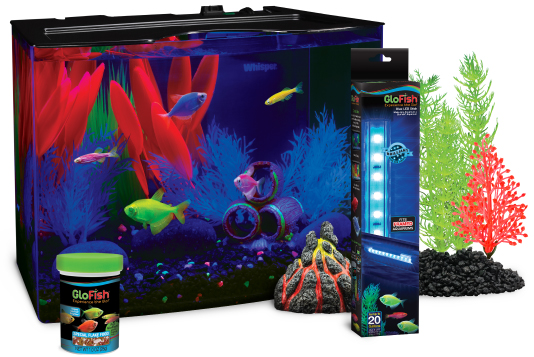As an aquarium enthusiast who has spent countless hours designing the perfect underwater paradise for my GloFish, I can attest to the transformative power of proper decorations. GloFish are stunning creatures that thrive in vibrant and well-decorated environments. In this comprehensive guide, we’ll delve into the best GloFish aquarium decorations, tips for creating a lively habitat, and personal insights from my experiences. Let’s splash into the colorful realm of GloFish decor!
Understanding GloFish
Before we dive into decorations, let’s take a moment to understand what makes GloFish so special. GloFish are genetically modified fish that fluoresce under blue or ultraviolet light. Initially developed for scientific research, they have become popular pets due to their striking colors and playful behavior.
Choosing the Right Species
GloFish come in various species, including:
- GloFish Betta
- GloFish Tetra
- GloFish Barb
- GloFish Danio
Each species has unique characteristics and care requirements, so it’s essential to know which type you’re working with when selecting decorations.
Why Decorations Matter
Decorations play a crucial role in the well-being of your GloFish. They provide hiding places, reduce stress, and create a visually appealing environment that highlights the beauty of these glowing fish.
Benefits of Using Aquarium Decorations
- Stress Reduction: Decorated tanks offer hiding spots and territories, thus minimizing stress among fish.
- Enhanced Visual Appeal: A well-decorated aquarium can be a stunning centerpiece in your home.
- Encouraging Natural Behavior: Decorations can inspire natural behaviors such as exploring and foraging.
Types of GloFish Aquarium Decorations
1. Plants
Plants provide both aesthetic appeal and functional benefits. They help maintain water quality and create natural hiding spots.
Live vs. Artificial Plants
Here’s a quick comparison:
| Feature | Live Plants | Artificial Plants |
|---|---|---|
| Maintenance Level | Higher | Lower |
| Water Quality Benefits | Yes | No |
| Aesthetic Appeal | Natural Look | Variety of Colors |

2. Substrates
The substrate you choose can significantly change your aquarium’s look and feel. Brightly colored gravel can enhance the GloFish’s glow.
Recommended Substrate Types
- Colored Gravel
- Sand
- Aquarium Soil for Plants

3. Ornaments
From castles to driftwood, ornaments add a playful element to your tank. Choose decorations that are safe for aquatic life and easy to clean.
Pros and Cons of Using Ornaments
- Pros:
- Creates focal points in the tank.
- Provides hiding spots for timid fish.
- Easy to rearrange for a fresh look.
- Cons:
- Can harbor algae if not cleaned regularly.
- Some may be sharp and harm fish.

4. Backgrounds
Using a colorful or themed background can enhance the visual appeal and make your GloFish pop even more.
Popular Background Options
- Solid Color Films
- 3D Scene Backdrops
- Nature-Inspired Themes

Decorating Tips for Your GloFish Aquarium
To create a captivating and thriving environment, consider the following tips:
1. Balance Color and Light
Since GloFish fluoresce under blue light, arranging your decorations to maximize this effect can be breathtaking. Use dark substrates and bright ornaments to create contrast.

2. Create Layers
Layering decorations—placing taller items in the back and shorter ones in the front—adds depth to your aquarium and gives your fish more space to explore.
3. Avoid Overcrowding
While it’s tempting to use lots of decorations, overcrowding can restrict swimming space. Aim for a balanced look that allows for open swimming areas.

4. Safety First
Always choose non-toxic decorations. Avoid anything sharp or with small parts that GloFish could ingest.
Maintaining Your Decorated Aquarium
Regular maintenance is key to keeping your aquarium beautiful and healthy. Here are some essential tips:
1. Regular Water Changes
Frequent water changes help maintain water quality, which is crucial for the health of your GloFish.
2. Clean Decorations
Use a soft brush to clean ornaments and remove algae buildup without scratching surfaces.
3. Monitor Plant Health
If you opt for live plants, make sure to check their health regularly and prune as needed.
Conclusion
Decorating your GloFish aquarium can be an immensely rewarding and enjoyable experience. With the right decorations, you can create a vibrant and safe environment that showcases the beauty of your GloFish while providing them with the space they need to thrive. Remember, the best aquarium is one that reflects your unique style while meeting the needs of its inhabitants. Happy decorating!
FAQs about GloFish Aquarium Decorations
1. What types of decorations are safe for GloFish?
Safe decorations include smooth ornaments, non-toxic plants, and substrates that don’t harm the fish. Always check labels for safety certifications.
2. How often should I change the decorations in my GloFish aquarium?
There’s no set schedule, but consider refreshing your decor every few months or when you notice algae buildup or wear and tear.
3. Can GloFish live with other fish?
Yes, GloFish can coexist with many peaceful community fish. Just ensure tank mates are compatible in size and temperament.
4. What lighting is best for enhancing GloFish colors?
Blue LED lighting is ideal, as it enhances their fluorescent colors, making your GloFish pop!
5. Are there any specific plants that work best with GloFish?
Fast-growing plants like Java Fern, Anubias, and Hornwort are excellent choices as they can help in maintaining water quality while providing cover.
6. How do I keep my aquarium decorations clean?
Regularly clean ornaments with a soft brush during water changes. Avoid using soap or chemicals that could harm fish.